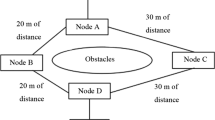Abstract
In order to optimize the artificial intelligence routing algorithm, combined with the calculation of the direction of the vector space model, three strategies are proposed to optimize the A* algorithm. The A* algorithm is widely used in the fields of GIS system and game path finding system. However, with the expansion of the scale of the search map, its performance consumption has increased exponentially. First of all, the first step of A* algorithm is to move towards the target direction by using directional factors, so that the intermediate route process will approach the shortest path as soon as possible. Secondly, the direction factor is used to ensure that the path finding of A* algorithm is the priority point in the direction of the target. Finally, the fault tolerance process is carried out. When the direction factor is guided to the “dead end”, it can be traced back, to ensure that the shortest path can be found at the end. The results show that the A * optimization algorithm is effective. The performance of A * optimization algorithm is about 20–50% higher than the traditional A * algorithm. The best case reached 88.6%. Therefore, the proposed optimization method improves the efficiency of the algorithm and reduces the performance consumption of the algorithm.








Similar content being viewed by others
References
Kuila, P., Jana, P.K.: Energy efficient clustering and routing algorithms for wireless sensor networks: particle swarm optimization approach. Eng. Appl. Artif. Intell. 33(1), 127–140 (2014)
Ilin, V., Simić, D., Tepić, J., et al.: A survey of hybrid artificial intelligence algorithms for dynamic vehicle routing problem. Lecture Notes Comput. Sci. 9121, 644–655 (2015)
Azharuddin, M.D., Kuila, P., Jana, P.K.: Energy efficient fault tolerant clustering and routing algorithms for wireless sensor networks. Comput. Electr. Eng. 41 (C), 177–190 (2015)
Gupta, S.K., Jana, P.K.: Energy efficient clustering and routing algorithms for wireless sensor networks: GA based approach. Wirel. Pers. Commun. 83(3), 1–21 (2015)
Hong, S., Han, K.H.: Tree-based routing algorithms on wireless sensor networks: survey. J. Syst. Inf. Technol. 17(2), 216–221 (2014)
Al-Rawi, H.A.A., Ming, A.N., Yau, K.L.A.: Application of reinforcement learning to routing in distributed wireless networks: a review. Artif. Intell. Rev. 43(3), 381–416 (2015)
Saltouros, M.P., Verentziotis, E.A., Markaki, M.E., et al.: An efficient hybrid genetic algorithm for finding (near-) optimal steiner trees: an approach to routing of multipoint connections. Int. J. Comput. Appl. 22(3), 159–165 (2015)
Marinakis, Y., Marinaki, M., Migdalas, A.: A hybrid clonal selection algorithm for the location routing problem with stochastic demands. Ann. Math. Artif. Intell. 76(1–2), 121–142 (2016)
Fan, Y.H.: Line probe routing algorithm implementation for SOC. Front. Artif. Intell. Appl. 274, 315–320 (2015)
Maghayreh, E.A., Al-Haija, S.A., Aljawarneh, S., et al.: BeesAnts: a new nature-inspired routing algorithm. Int. J. Commun. Netw. Distrib. Syst. 10(1), 83–97 (2013)
Kumaravel, K., Marimuthu, A.: An efficient multi-path routing algorithm based on hybrid firefly algorithm for wireless mesh networks. Res. J. Appl. Sci. Eng. Technol. 10(2), 159–168 (2015)
Wang, X., Cheng, H., Huang, M.: Multi-robot navigation based QoS routing in self-organizing networks. Eng. Appl. Artif. Intell. 26(1), 262–272 (2013)
Buyukyildiz, M., Tezel, G., Yilmaz, V.: Estimation of the change in lake water level by artificial intelligence methods. Water Resour. Manage 28(13), 4747–4763 (2014)
Akinwande, O.J., Bi, H., Gelenbe, E.: Managing crowds in hazards with dynamic grouping. Access IEEE 3(4), 1060–1070 (2015)
Dalfard, V.M.: A new intelligence algorithm for determination of shortest path for dynamic guidance of vehicles based on service level criterion. Int. J. Oper. Res. 19(4), 497–512 (2014)
Acknowledgements
This research is based upon work supported in part by the National Natural Science Foundation of China (No. 61502350, U1536114). The views and conclusions contained herein are those of the authors and should not be interpreted as necessarily representing the official policies or endorsements, either expressed or implied, of any of the above organizations or any person connected with them.
Author information
Authors and Affiliations
Corresponding author
Rights and permissions
About this article
Cite this article
Meng, Q., Zhang, J. Optimization and application of artificial intelligence routing algorithm. Cluster Comput 22 (Suppl 4), 8747–8755 (2019). https://doi.org/10.1007/s10586-018-1963-z
Received:
Revised:
Accepted:
Published:
Issue Date:
DOI: https://doi.org/10.1007/s10586-018-1963-z




